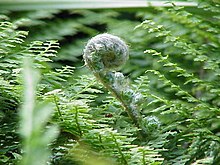
Thelypteridaceae is a family of about 900 species of ferns in the order Polypodiales. In the Pteridophyte Phylogeny Group classification of 2016, it is placed in the suborder Aspleniineae. Alternatively, the family may be submerged in a very broadly defined family Aspleniaceae as the subfamily Thelypteridoideae.

Phegopteris is a genus of ferns in the family Thelypteridaceae, subfamily Phegopteridoideae, in the Pteridophyte Phylogeny Group classification of 2016. They are known collectively as the beech ferns. Species are native to Asia, North America and Europe.

Pteris (brake) is a genus of about 300 species of ferns in the subfamily Pteridoideae of the family Pteridaceae. They are native to tropical and subtropical regions, southward to New Zealand, Australia, and South Africa, north to Japan and North America. 78 species are found in China. Some species of Pteris have considerable economic and ecological value, such as Pteris multifida, Pteris ensiformis, Pteris vittata can be used for ornamental purposes; as a hyperaccumulator, Pteris multifida and Pteris vittata can be used to control soil pollution.

The Dryopteridaceae are a family of leptosporangiate ferns in the order Polypodiales. They are known colloquially as the wood ferns. In the Pteridophyte Phylogeny Group classification of 2016 (PPG I), the family is placed in the suborder Polypodiineae. Alternatively, it may be treated as the subfamily Dryopteridoideae of a very broadly defined family Polypodiaceae sensu lato.

Cyrtomium is a genus of about 35 species of ferns in the family Dryopteridaceae, subfamily Dryopteridoideae, according to the Pteridophyte Phylogeny Group classification of 2016. Species are native to Asia, Africa, and the Pacific Ocean islands (Hawaii). It is very closely related to the genus Polystichum, with 2016 research suggesting it should be included in a clade sister to Polystichum s.s.

Microsorum is a genus of ferns in the family Polypodiaceae, subfamily Microsoroideae, according to the Pteridophyte Phylogeny Group classification of 2016 (PPG I). The species are tropical. Like most ferns, they grow from rhizomes, rather than roots. The genus name is often misspelled "Microsorium" or "Microsoreum". It includes some species that are lithophytic rheophytes.

Alsophila is a genus of tree ferns in the family Cyatheaceae. It has also been considered to be a section in the subgenus Cyathea of the genus Cyathea.

Aleuritopteris is a genus of ferns in the Cheilanthoideae subfamily of the Pteridaceae. As with some other genera of the Cheilanthoideae, molecular phylogenetic studies have suggested that it is not monophyletic, and so may need to be circumscribed differently in future.

Arachniodes is a fern genus in the family Dryopteridaceae, subfamily Dryopteridoideae, in the Pteridophyte Phylogeny Group classification of 2016. A number of species in this genus are known as "holly ferns".

Bolbitis is a genus of ferns in the family Dryopteridaceae, subfamily Elaphoglossoideae, in the Pteridophyte Phylogeny Group classification of 2016.

Tectaria is a genus of fern in the family Tectariaceae, according to the Pteridophyte Phylogeny Group classification of 2016. Halberd fern is a common name for species in this genus.

Woodsia is a genus of ferns in the family Woodsiaceae. Species of Woodsia are commonly known as cliff ferns. In the Pteridophyte Phylogeny Group classification of 2016 (PPG I), it was the only genus in the family Woodsiaceae. In 2020, Physematium was split off from Woodsia on the basis of molecular phylogenetic evidence. As of June 2023, Plants of the World Online continued to treat Physematium as a synonym of Woodsia.

Deparia is a genus of ferns. The Pteridophyte Phylogeny Group classification of 2016 places the genus in the family Athyriaceae, although other sources include it within an expanded Aspleniaceae or Woodsiaceae.

Christella is a genus of around 70-80 species of ferns in the subfamily Thelypteridoideae of the family Thelypteridaceae in the Pteridophyte Phylogeny Group classification of 2016. Other sources sink Christella into a very broadly defined genus Thelypteris. The genus was named after Konrad H. Christ, a Swiss botanist. The distribution of these plants is mostly in the tropics and sub tropical areas. An Australian example is C. dentata.

Pyrrosia is a genus of about 100 fern species in the polypod family, Polypodiaceae. Like other species in Polypodiaceae, the species of Pyrrosia are generally epiphytic on trees or rocks, a few species are terrestrial. The Latin name of Pyrrosia comes from the Greek pyrrhos (red), which refers to its leaves that are red due to the sporangia.

Polystichum mohrioides is a fern in the family Dryopteridaceae. It is found only in the Falkland and South Georgia Islands in the South Atlantic Ocean.

Goniophlebium is a genus of ferns in the family Polypodiaceae, subfamily Microsoroideae, according to the Pteridophyte Phylogeny Group classification of 2016 (PPG I).

Lepisorus is a genus of ferns in the family Polypodiaceae, subfamily Microsoroideae, according to the Pteridophyte Phylogeny Group classification of 2016 (PPG I).

Polystichum drepanum, also known as Madeira shield-fern, is a species of fern in the Dryopteridaceae family.




















